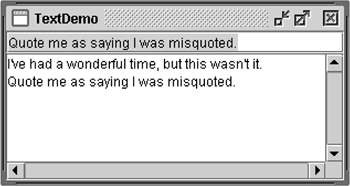How to Use Text Fields
| < Day Day Up > |
| A text field is a basic text control that lets the user enter a small amount of text. When the user indicates that text entry is complete (usually by pressing Enter), the text field fires an action event. If you need to obtain more than one line of input from the user , you should use a text area instead. The Swing API provides several classes for components that are either varieties of text fields or that include text fields.
Figure 85 displays a basic text field and a text area. The text field is editable; the text area isn't. When the user presses Enter in the text field, the program copies the text field's contents to the text area and then selects all the text in the text field. Figure 85. The TextDemo application with two Groucho Marx quotations.
textField = new JTextField(20); textField.addActionListener(this); The integer argument passed to the JTextField constructor, 20 in the example, indicates the number of columns in the field. This number is used along with metrics provided by the field's current font to calculate the field's preferred width. It does not limit the number of characters the user can enter. To do that, you can use either a formatted text field or a document listener, as described in Text Component Features (page 64) in Chapter 3. Note: We encourage you to specify the number of columns for each text field. If you don't specify the number of columns or a preferred size, then the field's preferred size changes whenever the text changes, which can result in unwanted layout updates. The next line of code registers a TextDemo object as an action listener for the text field. Here's the actionPerformed method that handles action events from the text field: private final static String newline = "\n"; ... public void actionPerformed(ActionEvent evt) { String text = textField.getText(); textArea.append(text + newline); textField.selectAll(); } Notice the use of JTextField 's getText method to retrieve the text currently contained by the text field. The text returned by this method does not include a newline character for the Enter key that fired the action event. You've seen how a basic text field can be used. Because JTextField inherits from JTextComponent , it's very flexible and can be customized almost any way you like. For example, you can add a document listener or document filter to be notified when the text changes and (in the filter case) modify the text field accordingly . Information on text components is in Text Component Features (page 64). Before customizing a JTextField , however, make sure that one of the other components based on text fields won't do the job for you. Often, text fields are paired with labels that describe the text fields. See Examples That Use Text Fields (page 426) for pointers to examples of creating these pairs. The Text Field APITables 96 through 98 list the commonly used JTextField constructors and methods. Other methods you are likely to call are defined in JTextComponent and listed in The Text Component API (page 77). Also refer to the JTextField API documentation at: http://java.sun.com/j2se/1.4.2/docs/api/javax/swing/JTextField.html. You might also invoke methods on a text field that it inherits from its other ancestors , such as setPreferredSize , setForeground , setBackground , setFont , and so on. See The JComponent Class (page 53) in Chapter 3 for tables of commonly used inherited methods. Table 96. Setting or Getting the Field's Contents
Table 97. Fine-Tuning the Field's Appearance
Table 98. Implementing the Field's Functionality
Examples That Use Text FieldsThis table shows a few of the examples that use JTextField and where those examples are described. For examples of code that's similar among all varieties of text fields, such as dealing with layout, also look at the example lists for related components such as formatted text fields and spinners.
|
| < Day Day Up > |
EAN: 2147483647
Pages: 171
